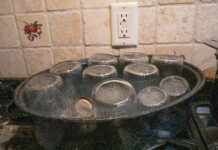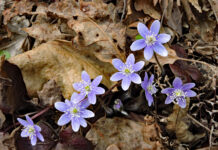In the event of a fire or hay smoldering, a fire department should be contacted immediately. However, there are ways you can reduce the damage.

1Fire hazards
Recognizing fire hazards sooner rather than later can help limit the damage caused by hay fires. Be on the look out for these hazards:
- Flare-ups: When the internal hay bale temperature is between 150 F and 170 F, the potential exists for spontaneous combustion, and hay should be moved to allow it to cool. If the temperature is at the higher end of the range, moving the hay could expose it to oxygen and cause flare-ups. Contact your local fire department and have water hoses available.
- Burned-out cavities: Cavities form when temperatures deep within stored hay reach high-temperature levels and the hay has burned. A person can become trapped in a burned-out cavity. Due to the risk of a person falling into a burned-out cavity, at least two people should investigate a hay mow.
- Toxic gas: Toxic gasses such as carbon monoxide can be released by smoldering and burning hay. Chemically treated hay may emit additional toxic gas vapors. A trained fire-rescue worker with a self-contained breathing apparatus should be called to assist at the scene.
2When a fire occurs
In the event of a fire be sure to cover all your bases and take the following steps.
- Account for all personnel on your farm.
- Check the area for flammable products. If any are present, immediately leave the area and alert firefighters.
- Determine whether electricity needs to be turned off.
- If the hay fire is located inside a building that houses livestock, consider personal safety before moving livestock.
- Remove any extra vehicles or machinery from the area around the fire to clear space for the fire service equipment.
- Stage bale-moving machinery out of the immediate fire area, but have it available to help move bales, as directed by firefighters.
- Retrieve material safety data sheets (MSDS) for any chemical preservatives that may have been used on the hay for firefighters to review.
3Things to remember
Remember these tips to reduce the risk of a hay fire and to better help first responders.
- Most hay fires, related to moisture levels, occur in the first six weeks.
- Bale hay at moisture levels of 20 percent or less.
- Keep baled hay dry by covering it or storing it inside.
- Monitor internal bale temperatures on a regular basis.
- Ventilation should change based on the temperature of the hay. Increase ventilation for hay at lower temperatures to cool bales. Stop ventilating hay that reaches over 175 F because increased air flow could feed a fire.
- Keep records of crop preservatives used to show fire personnel should a fire break out.
4Medical help
Moving hay bales is hot, smoky and physically demanding. Individuals involved at the scene need to be monitored and should receive medical attention if they exhibit signs related to smoke inhalation, heart attacks or other injuries.
Sources: Preventing fires in baled hay and straw (2012), extension.org.
(Farm and Dairy is featuring a series of “101” columns throughout the year to help young and beginning farmers master farm living. From finances to management to machinery repair and animal care, farmers do it all.)
More Farming 101 columns:
- How to prevent hay fires
- How to extend the life of your fence
- 10 safety tips for installing electric fences
- How to chose the right fence for your farm
- How to create a fencing plan
- 7 steps for easy sprayer calibration
- Prepare for planting season, Part 2: Calibration
- Prepare for planting season, Part 1: The Basics
- 7 tips to improve security on your farm
- 5 tips to protect your farmland
- 3 measures to deal with severe farm debt
- How to buy time to catch up on farm debt
- 6 tips to manage income on the farm
- 5 tips to recognize and deal with farm stress
- How to prepare a livestock birthing kit
- 5 tips for marketing your farm
- How to develop farm mission, vision statements
- 5 tips for setting farm goals
- 2 types of livestock insurance policies
- 6 things you need to know about WFRP plans
- 3 basics of crop insurance
- How does liability insurance work on the farm?
- Why do I need farm insurance?
- How to understand and use Ohio’s CAUV
- How to utilize the Pa. Clean and Green Act
- 9 tips for filing farm taxes
- 8 reasons record keeping for taxes is essential
- 5 tips for post-harvest storage
- 7 tips for family meetings on the farm
- 4 tips for balancing your farm and family
- 4 tips for communicating on the family farm
- 4 tips for firing an employee
- 6 tips for keeping good farm help
- 4 tips for recruiting farm labor
- 5 general farm labor laws
- 4 tips for employing minors
- 4 tips for PTO safety
- 5 things young farmers should know about finances
- The farm balance sheet
- 5 items for your farm’s cash flow statement
- Personal and business records: Keep them separate
- What to include in your farm business plan
- How to approach a lender: Tips for getting a farm loan
- How to use microloans to get your farm started
- Saving for the future: 6 tips for young farmers
- How to create a farm safety kit
- 5 tips for child safety on the farm
- 4 tips for transporting livestock
- 5 ways to better understand tractor stability
- 6 farm equipment hacks













Excellent article. Stacked hay is also a problem. If hay has come from a series of field you may have some bales that were baled wet. These can start to decay/smolder. Heat is an alert and bales should be removed immediately and opened to cool off. Move hay as far as possible from rest of stack and any structures. This is an emergency and needs immediate attention.
It’s great to know that you should keep baled hay dry by covering it or storing it inside. My brother is moving to a farm soon and he was wondering how he can protect his hay bales. I’ll be sure to tell him to keep the bales dry by covering them or storing them inside.